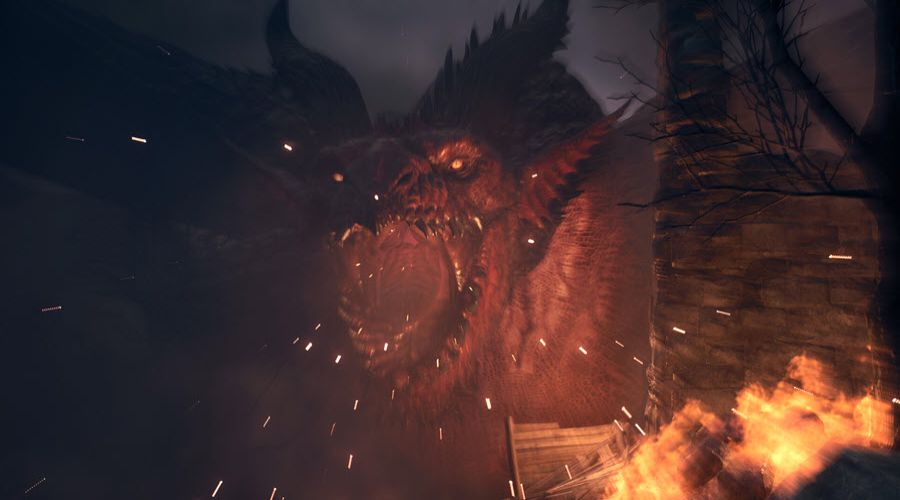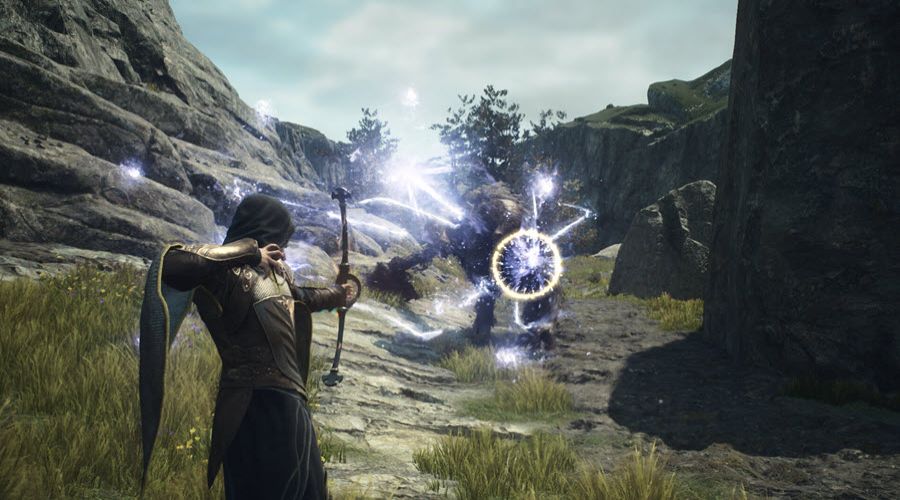Dragon's Dogma 2

Review
After more than ten years, the long-awaited sequel of one of the smallest but most beloved Capcom franchises finally arrives and let me tell you, it’s incredible that a game like this exists. Dragon’s Dogma 2 is an improved version of the first game that takes place in a world four times bigger and introduces a new story that shares some similarities with the previous one. Playing the first game is not required because you will be doing the same stuff here, but it’s still fun and recommended if you want to see how it all started and experience a slightly different story that is shaped by your actions.
Just like the prequel, you start the adventure by creating your own protagonist through one of the most impressive character editors I have ever seen. You can choose a random, pre-defined character, or create one by modifying each part of the body in great detail. The main choices you will make here will be between human or beastern race (the latter being like the Khajiit from Skyrim), which don’t seem to have consequences in-game except for how people refer to you. The other choice is selecting your starting vocation, which defines your combat style and abilities (you will be able to change vocation later). Keep in mind that you won’t be able to change appearance until you visit the Barber shop later in the game. You will also need to create your own pawn the same way, an ally that will always accompany you through the journey. Needless to say, I spent nearly two hours checking all the options available in the editor and creating my characters, trying to give them the most realistic look.

After finishing with the character editor, you start the game through a classic prologue that presents the story’s main theme. You are the Arisen, a person chosen by the Grand Dragon who devours your heart and gives you plenty of authority. What you do with this power is up to you, but you will soon get mixed up with the political intrigues between the two available kingdoms, Vermund and Battahl. Compared to the first game, the story is way better and characters have their own (sometimes optional) plots that characterize them more. The choices you can make during certain important plot moments have long-term consequences for you and the world, including multiple endings.
Dragon’s Dogma 2 goes against the traditional way of playing games, supported by plenty of info and suggestions. This is a game that, after a short tutorial, stops holding your hand and lets you explore the world at your own pace. The map you have is entirely unexplored and you gradually unveil it as you walk through every corner of the world. Exploration really requires your full attention, asking you to look out for details in the landscape, to find unseen paths that may lead you to a treasure chest or hidden locations, such as caves or abandoned outposts, and rewards your curiosity with new quests and unique items. Fast travelling is very limited and requires using some rare ferrystones, so most of the time you will walk through the same roads or you will ride oxcarts that only move through pre-defined locations and are vulnerable to enemy ambushes. The beautiful thing is that this world is mostly unscripted and highly interactive, so you can always find something that catches your attention while reaching the destination.
The quest design is something really unique. As someone who loved Elden Ring’s subtle ways of doing quests, this is something I’m always excited to see in new games. No check lists, no on-screen suggestions, no info on what reward you will get by completing a quest. There are also some time-sensitive quests that once accepted give you limited time for completion, so accepting many of them can easily make you fail some due to the lack of time. Some side quests will also disappear if you continue through the main quest, so the best approach is to explore everything you can before moving forward with the main story. There are often multiple ways for completing a quest and they have consequences for the characters involved, going from really tragic to happy endings. Quest givers aren’t marked on the map, so you need to look for NPCs who stand out from the crowd and talk to everyone multiple times because some quests only become available with the passage of time (in-game days) or after completing certain quests.
Combat is brutal. You have a health and stamina bar, but each action like attacking, using abilities, sprinting or jumping consumes the latter. Enemies feel like a real threat, especially at the beginning when you are weak but need to face giant monsters like cyclopes, ogres and griffins, which you can even climb and attack, like in Shadow of the Colossus. Compared to the first game, the bestiary is expanded but not as much as I hoped, considering the map is bigger. Too often you will fight against the same group of bandits, goblins, wolves or harpies, which later in the game become more annoying than challenging.
Pawns are another important gameplay element. In addition to your own trustworthy pawn, you can add two more to your party. You can recruit them from other players online and likewise other players can hire your pawn in their own worlds. There are multiple incentives for doing so, because pawns constantly learn from experience. If they have discovered a treasure chest, finished a quest or defeated a dangerous monster, they will be able to give you suggestions when you face the same situation. They can even ask you to follow them and show you how to complete a certain quest, which is very player-friendly and helps those who might feel frustrated by the general lack of info. The pawn’s AI is surprisingly good and quickly adapts to the combat conditions. They are able to assist you in many ways, jumping on enemies, grabbing them and even using traps or other objects found in the environment. Pawns can also get sick with the Dragonsplague, a contagious disease that, if not cured in time, can have disastrous consequences for all living NPCs, including quest-givers (you can revive them, but it takes lot of time and effort).
Graphically speaking, Dragon’s Dogma 2 is the first open world that runs on the RE Engine and it’s simply gorgeous. Thanks to photogrammetry, characters appear more photo-realistic and even the environment textures and global illumination are impressive. Unfortunately, the game includes Denuvo Anti-tamper and the performance isn’t really great. The problem arises mainly when moving through the big cities where the frame rate drops drastically to the lower 20s, which isn’t acceptable.
As for micro-transactions, there aren’t really any. Yes, you have a list of purchasable DLCs from the Steam store, but it was the same for Resident Evil 4 Remake and Monster Hunter, yet nobody panicked. The most important thing is that these items are really optional and can all be obtained in-game without too much effort. Just to be clear, there is no in-game shop and no advertising banners, this is not Diablo IV.
Dragon’s Dogma 2 is everything you would expect from an old-fashioned action RPG that wins against the genre’s modern conventions. A magnificent sequel set in a highly interactive fantasy world where anything can happen. You would be doing yourself a disservice if you didn't play it.
Review written by Sonic Punk for Zeepond.com
Dragon's Dogma 2 Steam Store Page
Positives
+ The most detailed character editor to date+ Satisfying exploration that rewards curiosity and attention
+ Intense and well-varied combat against giant monsters
+ Unique pawn system with improved AI
+ Superb quest design with choices and consequences
Negatives
- Poor optimization and frame drops in big cities- Denuvo anti-tamper
- Some minor gameplay elements can break the game’s difficulty
Review Summary
Dragon’s Dogma 2 is everything you would expect from an old-fashioned action RPG that wins against the genre’s modern conventions. A magnificent sequel set in a highly interactive fantasy world where anything can happen.
Share this review!
Zeepond Rating: 9/10










Video
Game Categories
All Game Reviews (1354)Hardware Reviews (0)
Action (341)
Adventure (151)
Alpha Games (2)
Anime (5)
Board Games (3)
Casual (135)
First Person (19)
First Person Shooter (30)
Hardware (0)
Horror (38)
Massive Multiplayer Online (4)
Pixel Graphics (22)
Platformer (94)
Puzzles (65)
Racing (26)
Role Playing Game (62)
Simulation (53)
Sports (20)
Strategy (246)
Third Person (11)
Utility software (1)
Virtual Reality (22)

